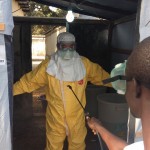This paper seeks to understand the fear many Guineans feel towards Ebola response initiatives and why the educators, doctors and burial teams have sometimes encountered resistance, occasionally violent. Resistance has been catastrophic for the epidemic, preventing treatment, contact tracing and quarantine, permitting its spread. The paper sketches a history of dissent and violence during the epidemic before showing how some actions that Ebola response teams interpret as ‘resistance’ are less actions ‘against’ Ebola response, than actions that have their own cultural logics. But the paper
Continue reading →
Funeral practices in Freetown are varied with differences between typical Muslim and Christian practices. Muslims typically bury the body the same day, or the day after, the death, whereas Christians might wait for up to several weeks while arrangements are made. Muslims normally bury bodies in a shroud, whereas Christians use a coffin. The bodies are typically prepared for burial (washed) by family members. This background paper gives more information on care and burial practices in Urban Sierra Leone.
The current outbreak of Ebola Virus Disease in Upper West Africa is the largest ever recorded. Molecular evidence suggests spread has been almost exclusively through human-to-human contact. Social factors are thus clearly important to understand the epidemic and ways in which it might be stopped, but these factors have so far been little analyzed. The present paper focuses on Sierra Leone, and provides data on the least understood part of the epidemic – the largely undocumented spread of Ebola in rural areas. Various forms of
Continue reading →
Case Studies on Contemporary Social Issues book by Barry Hewlett and Bonnie Hewlett. In this case study, readers will embark on an improbable journey through the heart of Africa to discover how indigenous people cope with the rapid-killing Ebola virus. The Hewletts are the first anthropologists ever invited by the World Health Organization to join a medical intervention team and assist in efforts to control an Ebola outbreak. Their account addresses political, structural, psychological, and cultural factors, along with conventional intervention protocols as problematic to achieving
Continue reading →
Haemorrhagic fevers have, par excellence, captured popular and media imagination as deadly diseases to come ‘out of Africa’. Associated with wildlife vectors in forested environments, viral haemorrhagic fevers such as Ebola, Marburg and lassa fever figure high in current concern about so-called ‘emerging infectious diseases’, their hotspots of origin and threat of global spread. Outbreak narratives have justified rapid and sometimes draconian international policy responses and control measures. Yet there is a variety of other ways of framing haemorrhagic fevers. There present different views concerning
Continue reading →
Viruses that cause haemorrhagic fevers have been popularized by the media as fierce predators that threaten to devastate global populations. Professor Melissa Leach says there is much to learn from combining local and scientific knowledge in dealing with these deadly pathogens.
As the worst Ebola epidemic on record shows no signs of abating in West Africa, fear and ignorance are increasingly said to be playing a role in its continued spread. Meanwhile, local practices such as the consumption of bushmeat and deforestation are the go-to explanations for the epidemic’s underlying causes. However, decades of anthropological research in the region by STEPS Centre and Institute of Development Studies (IDS) researchers, indicates not only that this picture is an over-simplification, but that disease control policies based on these ideas may be unhelpful.
The study analyzes the traditional beliefs and practices concerning leprosy of the Limba people of Sierra Leone. It shows that this dialectally diverse ethnic group has two views of leprosy and its cause, and two varieties of stigma associated with the disease. The Limba have abandoned their traditional treatments for leprosy in response to an effective leprosy control programme, but retained their traditional world view, including its definition of illness, which holds a person seriously ill only when he has severe pain or disability. Thus,
Continue reading →
This is a chapter on Kissi Funerals in the region of Guekedou and Kissidougou. Whilst this is based on fieldwork conducted in 1945-6, many of the ritual practices and meanings were current and observed in Kissi villages in 1991-3. For the Kissi, every life has three critical moments: birth, initiation, death. The primary role of the funeral ritual is to allow access to the rank of an ancestor; a more elevated social rank. Hence the first hours are given to expressing pain (or gladness for
Continue reading →
People who live in the Sherbro coastal area of Sierra Leone have a social organisation based upon descent from named ancestors and acestresses. Ancestors, the living, and those not yet born constitute a great chain of being. This continuum of existence is punctuated, and made discontinuous, by rites of passage (birth, puberty, death). Dying is a period of categorical ambiguity in which a person is still among the mundane living, but babbles of the past, a sign that he or she is also in the
Continue reading →






